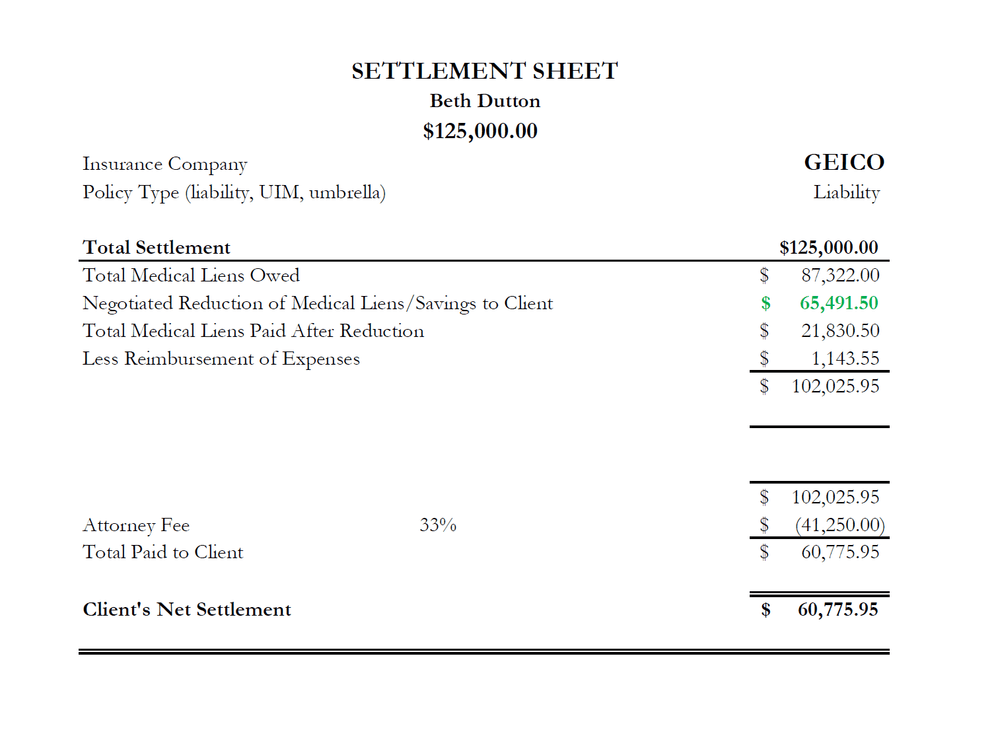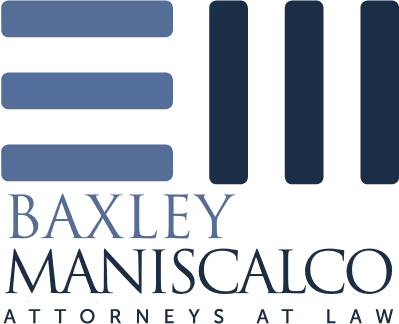Baxley Maniscalco Attorneys At Law
Generally, personal injury lawyers work on a contingency fee, which means that they do not get paid unless they win your case. If a personal injury lawyer agrees to take your case, they will typically advance all of the fees associated with pursuing the claim.
These fees and expenses include court costs and filing fees, subpoena fees, the cost of hiring investigators and other experts to prove liability and damages, the costs of ordering medical records, and other costs associated with bringing the case to trial. If you settle your case without the need for a trial, the expenses will typically be reimbursed to the attorney “off the top” of the total settlement.
The lawyer will then be paid their contingency fee from the total settlement amount. The remaining funds will then go to pay your medical liens and other outstanding bills. After these items are paid, the remaining funds go into your pocket.
What Is a Typical Contingency Fee on a Personal Injury Case in Alabama or Georgia?
The typical range for contingency fees charged on a personal injury matter in the states of Alabama and Georgia is 33% to 40%.
More complex or riskier cases may have higher contingency fees, such as a medical malpractice case.
However, it’s a good rule of thumb to assume that 33% to 40% is a reasonable contingency fee rate for a personal injury case.
What Is a Hospital Lien?
A hospital lien is a legal claim that a hospital has on the proceeds of a personal injury settlement or judgment. Hospital liens ensure that the hospital is paid for the medical treatment provided to a patient injured due to someone else's negligence or wrongdoing.
Hospital liens are typically used when the patient has received treatment at the hospital but has not yet paid for the treatment. The hospital will file a lien with the court to claim a portion of the settlement or judgment as payment for the medical treatment.
The amount of the hospital lien will depend on the amount of medical treatment provided to the patient and the applicable laws of the jurisdiction. It is important to work closely with an attorney to understand the terms of the hospital lien and to ensure that the hospital is paid in a timely and appropriate manner.
Hospital liens can be complex and may have a huge impact on the overall settlement or judgment in a personal injury case.
Sample Settlement Breakdown Sheet for a Personal Injury Insurance Payment

This settlement breakdown is based on one of the forms our office uses to disburse client funds when a personal injury settlement has been reached. Let’s look at each component of the settlement to see how much money the client finally received in their pocket after all fees and expenses were paid.
At the top of the form, you’ll see the total settlement amount of $125,000.
This settlement was from the liability insurance carrier, who, in this example, is GEICO. GEICO has offered $125,000 in settlement of the claims against the tortfeasor (the at-fault party, or the one responsible for causing the injuries to the plaintiff) and the plaintiff has accepted.
The total medical liens owed line shows the total amount of medical billing that has been done by all of the plaintiff’s medical providers. This amount will include providers such as transportation by a helicopter or ambulance from the scene to the hospital, emergency room treatment and all hospital billing, billing by the plaintiff’s primary care physician, and all other treatment providers, such as physical therapists, pain management providers, chiropractors, and specialists. If the plaintiff had surgery for any injuries, the cost of surgery will be included here as well.
The total medical billing in this case is $87,322.
The next line item depicted in green shows the amount of billing reduction the attorney was able to negotiate with the medical providers. This is an area where a good personal injury attorney really makes a difference. Negotiating your medical liens well does not make the attorney any additional money (their contingency fee gets paid from the total settlement if you recall), but it makes a HUGE difference to the amount of money that ends up in the injured person’s pocket when all is said and done.
This is an issue we are passionate about. We believe that attorneys have a moral and ethical duty to work diligently for their injured clients to achieve significant medical lien reductions so that the client actually ends up with the money they need to get back on their feet, physically and financially. When you’re choosing an attorney to represent you in your personal injury case, be sure to question them closely about how they handle medical lien reduction and the percentage total reduction they typically achieve in their cases.
The medical lien reduction achieved in this sample case is $65,491, or 75%.
After the reduction, the remaining medical liens that must be paid out of the plaintiff’s recovery total are $21,830.50.
Less Reimbursement of Expenses: this line item describes the advanced case costs that were paid upfront by the attorney. These include the filing fee, deposition costs, court costs, subpoena fees, and any expert fees that were retained to assist in proving the case to a jury.
The total case expenses in this case were $1,143.55.
The attorney’s contingency fee in this case was 33% of the total recovery. This is within the standard contingency fee range for the states of Alabama and Georgia, where a rate is not statutorily mandated. It is typical to see contingency fees between 33 and 40% for personal injury cases in Alabama and Georgia. If an attorney proposes a contingency fee rate of 50% or more in a “typical” personal injury matter in one of these states, ask more questions. Note that medical malpractice and other high-risk areas of practice may have higher associated contingency fees.
A “typical” personal injury matter would, for these purposes, be a car accident, motorcycle accident, slip and fall, or dog bite injury, to name a few examples.
The attorney’s fee in this case was $41,250.00.
This brings us to the client’s net settlement for the personal injury claim. The client will receive a check for this amount free and clear, with no outstanding bills or obligations left to pay. This is the number that goes "in the client’s pocket."
The Client’s Net Settlement in This Case Was $60,775.95
A key takeaway from this example: the total medical billing in the case, if it had been paid without negotiating for reductions, would have left only $37,678 in the client’s pocket. By diligent lien negotiation, the attorney got the client over $20,000 more to take home from the settlement.
We share this example because we don’t like the mystery surrounding how personal injury lawyers are paid or how much money clients will end up with in their pockets. We don’t believe in making pie-in-the-sky promises or focusing on the total settlement amount. We know that what matters to our clients is the amount they get to bring home at the end of the day.
We want more people to understand how this system works so that more injured plaintiffs feel confident retaining an attorney to help them with their cases. The contingency system in Alabama and Georgia is designed to give every single injured person access to an excellent lawyer to help them with every stage of their case, from prelitigation negotiations to jury trial, and everything that happens in between.
